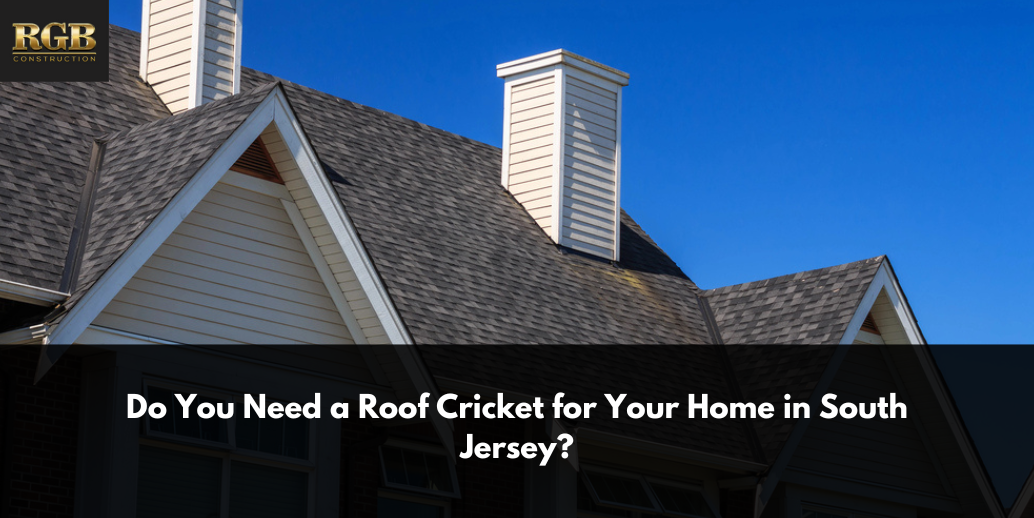The roof on your home is a system that comes together when all of the pieces are working optimally. For instance, the shingles help water sheet off the roof and into the gutters, which then direct that water away from the foundation via the downspout. Some roofs have an additional piece of hardware that is used to prevent water pooling around penetrations, such as skylights and chimneys. The hardware is known as a roof cricket, and it can be extremely valuable for some homes. The question is, “Do you need a roof cricket for your home in South Jersey?” Let’s find out.
Key Takeaways
- Roof crickets, also called saddles, redirect water away from roof protrusions like chimneys and skylights, preventing water buildup and damage.
- Crucial on low-slope roofs, crickets ensure proper drainage, preventing structural damage and debris buildup.
- Crickets vary based on roof slope; steep-slope crickets use wood framing, while low-slope ones incorporate sloped insulation and membrane roofing.
- Determine the need for a cricket by assessing local building codes, roof design, and potential water flow patterns.
- Seek guidance from experienced roofing professionals, like RGB Construction, for tailored advice and solutions.
What is a Roof Cricket?
Also known as a saddle, a roof cricket is a triangular object that is positioned by penetrations such as chimneys and skylights on a roof. The primary function of a roof cricket is to redirect water towards a designated drainage area, preventing water accumulation at the base of the obstacle. By splitting the run of water around the obstruction, crickets guide rainwater towards drains and downspouts, effectively directing it away from the roof’s surface. Additionally, they play a role in deterring the buildup of debris like leaves and sticks.
On roofs with low slopes, typically featuring a 1/4″ per foot slope integrated into the structure or achieved through tapered insulation, crickets are essential for diverting water towards drains and scuppers. The accumulation of standing water on low-sloped roofs can lead to structural damage and debris accumulation. Therefore, contractors install crickets strategically in low areas around the perimeter, between drains and wall scuppers, and near HVAC or electrical equipment and skylights.
The Different Types of Roof Crickets?
On steep-sloped roofs, crickets are typically constructed with wood framing and covered with metal or roofing material such as asphalt shingles. They adopt a half-diamond pattern and are utilized behind chimneys, skylights, HVAC or electrical equipment, and other penetrations. Metals like copper or galvanized steel are commonly used due to their resistance to rust and corrosion. All crickets necessitate metal flashing around the penetration to prevent water infiltration, which could lead to leaks, mold, mildew, and structural damage.
For low-slope roof systems, crickets are built using sloped rigid insulation and then enveloped with a membrane roofing system. These crickets are shaped in triangular or diamond patterns, featuring a slope double that of the roof to ensure a net-positive backslope. A quarter-diamond pattern is employed near the parapet wall, while a full diamond pattern is utilized between two roof drains.
Do You Need a Roof Cricket for Your Home in South Jersey?
Now to return to the main question: Does your home need a roof cricket? Some houses may not need a cricket installed. To help you figure out if you need one, here are some things to consider:
Local Building Codes
Take the time to thoroughly research and understand the building codes and regulations specific to South Jersey. Local authorities may have requirements regarding roof construction, including the installation of crickets for certain roof features. These codes are in place to ensure the safety and structural integrity of homes, particularly in regions prone to heavy rainfall like South Jersey.
Roof Design and Features
Conduct a detailed assessment of your roof’s design and structural features. Pay close attention to any elements that protrude from the roof, such as chimneys, skylights, or vents. These features can create potential areas for water accumulation during rain events, leading to leaks or structural damage over time. By identifying these areas, you can determine whether the installation of a roof cricket is necessary to redirect water flow and prevent pooling.
Potential Water Flow
Observe the typical water flow patterns on your roof, especially during heavy rainfall. Note any areas where water tends to accumulate or pool, as these spots may indicate the need for additional drainage measures like roof crickets. By understanding how water moves across your roof, you can identify problem areas and take proactive steps to address them before they cause damage.
Contact a Roofing Contractor in South Jersey About Roof Crickets Today
Some houses do not need roof crickets, but these additional pieces to the roofing system can be very beneficial in certain situations. If you are considering a roof cricket, it is important to seek guidance and advice from experienced roofing professionals in South Jersey, such as RGB Construction. Our professional team have the experience and knowledge to assess your roof’s specific requirements and recommend appropriate solutions, including the installation of crickets. We can provide valuable insights into local weather patterns, building standards, and the best practices for roof construction in the region.Get in touch with RGB Construction today by calling 856-264-9093 or by filling out the online form.







